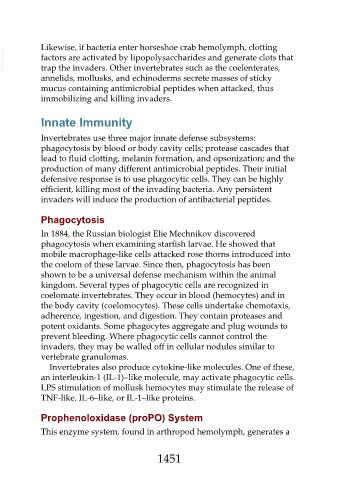Page 1451 - Veterinary Immunology, 10th Edition
P. 1451
Likewise, if bacteria enter horseshoe crab hemolymph, clotting
VetBooks.ir factors are activated by lipopolysaccharides and generate clots that
trap the invaders. Other invertebrates such as the coelenterates,
annelids, mollusks, and echinoderms secrete masses of sticky
mucus containing antimicrobial peptides when attacked, thus
immobilizing and killing invaders.
Innate Immunity
Invertebrates use three major innate defense subsystems:
phagocytosis by blood or body cavity cells; protease cascades that
lead to fluid clotting, melanin formation, and opsonization; and the
production of many different antimicrobial peptides. Their initial
defensive response is to use phagocytic cells. They can be highly
efficient, killing most of the invading bacteria. Any persistent
invaders will induce the production of antibacterial peptides.
Phagocytosis
In 1884, the Russian biologist Elie Mechnikov discovered
phagocytosis when examining starfish larvae. He showed that
mobile macrophage-like cells attacked rose thorns introduced into
the coelom of these larvae. Since then, phagocytosis has been
shown to be a universal defense mechanism within the animal
kingdom. Several types of phagocytic cells are recognized in
coelomate invertebrates. They occur in blood (hemocytes) and in
the body cavity (coelomocytes). These cells undertake chemotaxis,
adherence, ingestion, and digestion. They contain proteases and
potent oxidants. Some phagocytes aggregate and plug wounds to
prevent bleeding. Where phagocytic cells cannot control the
invaders, they may be walled off in cellular nodules similar to
vertebrate granulomas.
Invertebrates also produce cytokine-like molecules. One of these,
an interleukin-1 (IL-1)–like molecule, may activate phagocytic cells.
LPS stimulation of mollusk hemocytes may stimulate the release of
TNF-like, IL-6–like, or IL-1–like proteins.
Prophenoloxidase (proPO) System
This enzyme system, found in arthropod hemolymph, generates a
1451

